
- HOME
- 產品介紹
- 半導體事業部
- Hamamatsu Photonics
- Lamp
- Xenon Lamp & Mercury-Xenon Lamp
- Xenon Lamp & Mercury-Xenon Lamp
Xenon Lamp & Mercury-Xenon Lamp
![]() +886-2-8772-8910
+886-2-8772-8910
● Super-Quiet Xenon Lamp
These are lamps filled with xenon gas that emits "white light" at a high color temperature of 6000 K, which is close to that of sunlight and covers a broad continuous spectrum from the ultraviolet to infrared region (185 nm to 2000 nm). These xenon lamps are ideal as light sources for various types of photometric instruments such as spectrophotometers.

● Super-Quiet Mercury-Xenon Lamp
Mercury-xenon lamps produce high radiant energy especially in the ultraviolet region due to an optimal mixture of mercury and xenongas. These lamps possess features of both xenon gas and mercury discharge lamps. The spectral distribution includes a continuousspectrum ranging from ultraviolet to infrared of the xenon gas and strong mercury line spectra in the ultraviolet to visible region.
Compared to xenon lamps, the radiant spectrum in the ultraviolet region of mercury-xenon lamps is sharper in width and its peak is higher in intensity. These features make mercury-xenon lamps ideal as ultraviolet light sources.
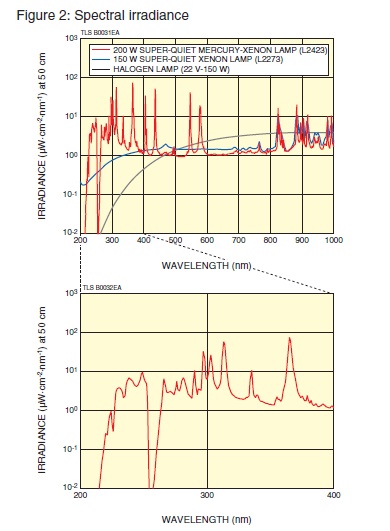
FEATURES
● No arc point shift
● High stability
Xenon lamp:
Fluctuation (p-p) 0.2 % Typ.
1.0 % Max.
Drift ±0.5 %/h Typ.
Mercury-xenon lamp:
Fluctuation (p-p) 0.5 % Typ.
2.0 % Max.
Drift ±0.5 %/h Typ.
● Long life
● Wide lamp lineup starting from low wattage input
● High intensity point light source
● High color temperature: 6000 K (Super-quiet xenon lamp)
● High UV intensity (Super-quiet mercury-xenon lamp)
APPLICATIONS
Super-Quiet Xenon Lamp
• Spectrophotometer
• Liquid chromatograph
• Fluorospectrophotometer
• Microscope Light Source
• Color analyzer, color scanner
• Solar simulator, etc.
Super-Quiet Mercury-Xenon Lamp
• Wafer inspection system
• Semiconductor photolithographic equipment
• Fluorescent microscopy
• Blood analyzer
• UV irradiation equipment, etc.
ARC "INSTABILITY (FLUCTUATION)" and "SHIFT"
Light source lamps used for high precision photometry must have good arc stability. However, cathodes used in conventional lamps have two shortcomings in terms of arc stability. One problem is that the arc emission point shifts intermittently due to inadequate electron emission from the cathode. The other problem is that the arc point shifts a little at a time due to the cathode tip wear that occurs with operating time as the lamp ages.
Hamamatsu super-quiet lamps employ a high performance "BI (Barium-Impregnated) cathode" developed totally in-house that eliminates the above problems to deliver extremely high stability. This durable cathode exhibits no wear at the cathode tip over operating time and the arc point does not shift. So there is no need to realign the optical system until the time finally comes when the lamp must be replaced.
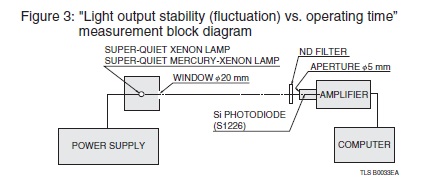

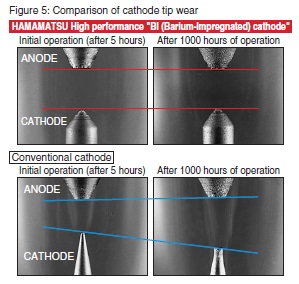
STRUCTURE AND OPERATION
These lamps have an oval bulb made of quartz glass (silica glass) in which a cathode and an anode face each other. The bulb for superquiet xenon lamps is filled with high-purity, high-pressure xenon gas.
The bulb for super-quiet mercury-xenon lamps is filled with a mixture of high-purity, high-pressure xenon gas and high-purity mercury. The lamps emit light by arc discharge. The lamps are installed vertically (or horizontally) with the anode at the upper side (some types of lamps are only installed vertically) and operate on DC. When the specified voltage is supplied across the anode and cathode, the lamp immediately starts discharging to form an arc discharge.
After the lamp lights up, several minutes are required to reach the maximum light output because the gas pressure inside the bulb changes until it reaches thermal equilibrium.
During lamp operation, the bulb wall temperature rises above 500 °C and the gas pressure inside the bulb increases to approximately 4 MPa which is 4 times higher than when the lamp is not operating.
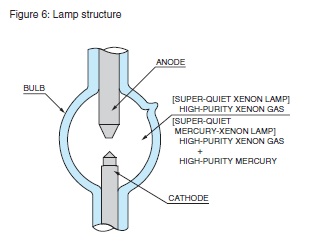
CHARACTERISTICS
● Irradiance
Super-Quiet Xenon Lamp
The irradiance of xenon lamps is continuous over the ultraviolet, visible and infrared regions. Some line spectra are emitted in thevisible to infrared regions.
Super-Quiet Mercury-Xenon Lamp
The irradiance of mercury-xenon lamps has strong line spectra from the ultraviolet to the visible region. This radiation spectrum includes both the radiation spectrum of xenon lamps and mercury line spectra.
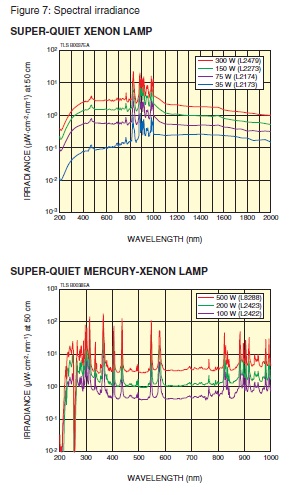
● Difference in Irradiance by Bulb Material
The irradiance differs according to the bulb material. Fused silica transmits light at wavelengths shorter than 240 nm, yet ozone-free silica cuts off light of wavelengths shorter than 240 nm. Select the bulb material that meets your application.
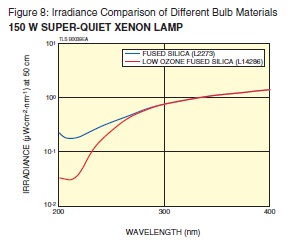
● Light Output Intensity Contour Map
Maximum light output intensity is more intense around the cathode, and decreases towards the anode.
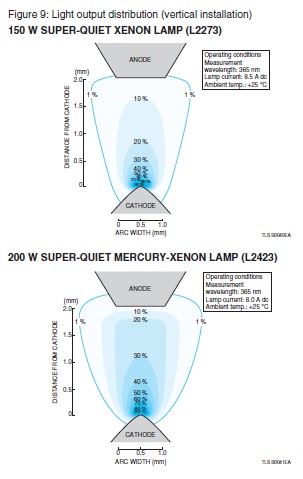
● Radiant Flux Distribution
The lamps emit a radiant flux distribution uniformly along the horizontal direction.
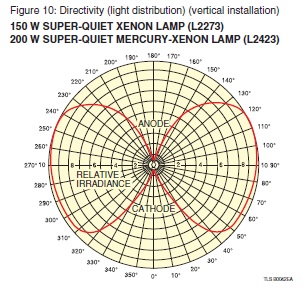
● Lamp Current and Lamp Voltage

● Light Output Intensity and Lamp Current
The light output intensity of a lamp is proportional to the lamp current.
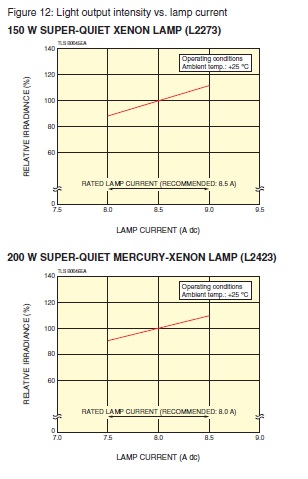
● Initial Stability of Light Output Intensity
After the lamp lights up, the light output intensity varies until the gas pressure inside the bulb reaches thermal equilibrium. It takes several minutes to reach the maximum light output.
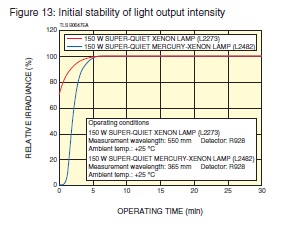
Light Output Intensity and Ambient Temperature
The light output intensity of a lamp also varies with ambient temperature. This is due to the change in light output intensity resulting from the change in gas pressure with temperature.
The ambient temperature must be kept constant to ensure stable lamp operation.
● Light Output Intensity and Operating Time
The light output intensity decreases over operating time. This is because of a loss of glass transmittance caused by blacking of the bulb wall due to evaporation of the cathode materials and solarization effect of ultraviolet radiation.
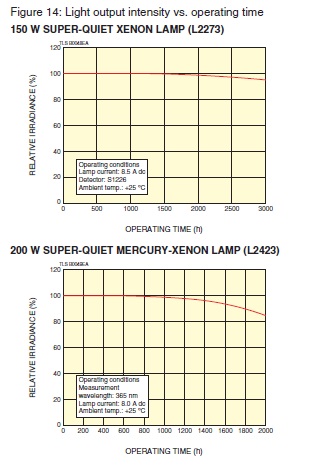
POWER SUPPLY
Lamps used as a light source for photometric applications must provide stable light output. To ensure stable lamp operation, the power supply must also provide high stability equal to or better than that of the lamp.
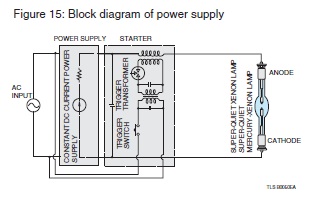
● Main Power Supply
Besides supplying the lamp with stable DC power, the main power supply gives the cathode an optimal operating temperature at a specified current. The cathode temperature is very important for lamp operation. A cathode temperature that is too high speeds up the evaporation of cathode materials. Too low of a temperature will increase the load on the cathode, causing unstable electron emission and greatly reducing the lamp service life.
The lamp current must be set within the specified range to operate the lamp stably over long periods of time. For this reason, the operating current value and its range are specified for each lamp type.
● Starter
The starter is for starting lamp discharge. It applies a high-frequency pulse to the lamp load by inductive coupling. (See Figure 14.) In the initial stage of lamp operation, the discharge starts at approximately 10 kV. However, this characteristic varies according to the drop in electron emission capability of the cathode or variations in the fill gas pressure.
In actual equipment operation, a trigger voltage of 20 kV to 30 kV should be applied to the lamp, while taking an ample safety margin into account.
